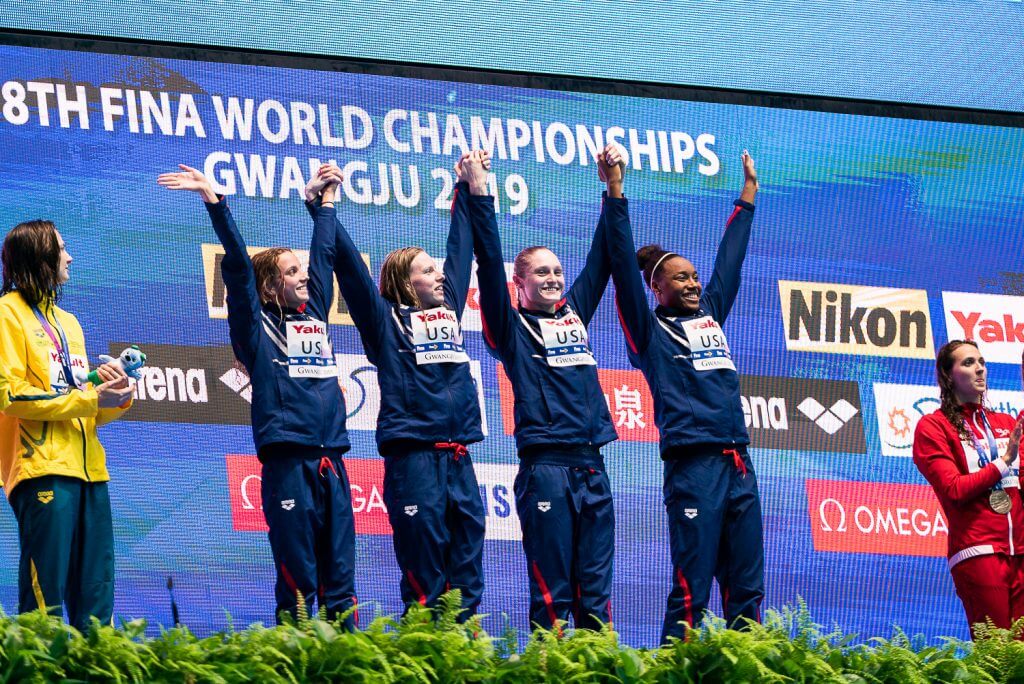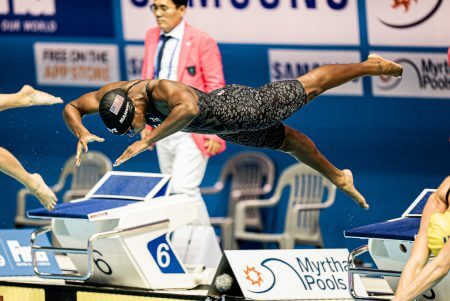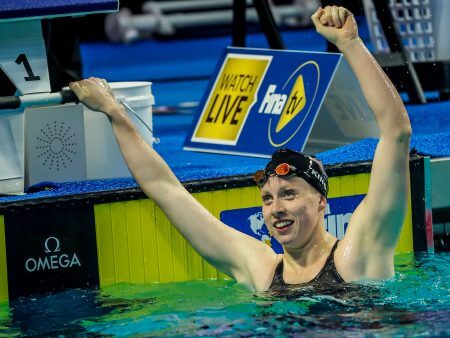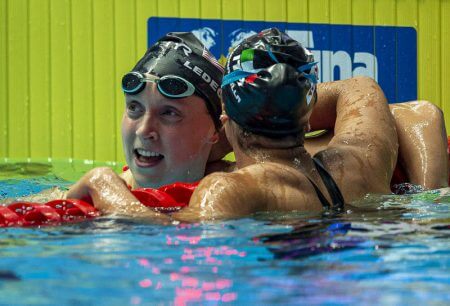Assessing the U.S. Women’s Swim Team Prior to Olympic Trials

Assessing the U.S. Women’s Swim Team Prior to Olympic Trials
Trying to preview and predict a swim meet is a very imperfect science. Whatever trends have developed could come crashing down, and it’s impossible to know who will win a race or how fast someone will swim. This year, forecasting the U.S. Olympic Trials is even more difficult thanks to the COVID-19 pandemic shutting down the entire summer competition season last year. For that reason, most of the best swimmers at Olympic Trials have not swum a tapered long course meet in almost two years.
However, despite that massive asterisk, we can use past results as well as times from this season to get a general perspective of what this Trials will look like, and for the U.S. women, the returns are really good. In 14 individual events at the 2019 World Championships, the American women won medals in only eight of them, but some of those misses are easily explained. Katie Ledecky would have been the heavy gold-medal favorite in the 1500 free and at least a medal contender in the 200 free, but she had to withdraw from both events because of illness. Lilly King would likely have been in the 200 breast mix, but she was disqualified for questionable reasons in prelims.
Between those results from Gwangju and some more recent developments, the American women should leave Omaha, Neb., after June 20 having qualified at least one medal favorite in every single event. That’s a little bit bold, so let’s go stroke-by-stroke to see the full picture.
Freestyle

Simone Manuel dives off the block at the 2019 World Championships — Photo Courtesy: Becca Wyant
The story of U.S. women’s freestyle centers on two names. Simone Manuel is the defending Olympic gold medalist in the 100 free and has won the last two world titles in the event, and she added a World Championships gold in the 50 free in 2019. Sure, Manuel will face some really good talent in both events at the Olympics, but barring any stunning swims between the American and Australian Olympic Trials, she should head to Tokyo as the slight favorite for gold in the 100 free and at least a medal favorite in the 50. Claire Curzan, meanwhile, has been 24.17 this year in the 50 free, which will raise the bar for qualifying for the Olympics.
And for all the freestyle events 200 meters and longer, you have Katie Ledecky. It’s impossible to see an on-form Ledecky being touched in the 800 free (where she is aiming for a third straight gold medal) and 1500 free (a brand new Olympic event where Ledecky owns the world record by a massive margin). Ledecky is probably the slight favorite over Australia’s Ariarne Titmus in the 400 free, and Leah Smith has won medals in that event at the 2016 Olympics and at the last two World Championships. And earlier this year, Ledecky posted her fastest 200 free since winning the 2016 Olympic gold, that 1:54.40 sitting first in the world rankings.
Backstroke
At the 2019 World Championships, Regan Smith crushed both backstroke world records, to the tune of a 57.57 in the 100 back and 2:03.35 in the 200 back. Since then, Australia’s Kaylee McKeown has dramatically closed the gap on Smith, the Americans are still very well set up here. The 100 back has been billed for months as the strongest event on the program for Olympic Trials and rightfully so. The event will include the world record-holder (Smith), the most recent world record-holder (Kathleen Baker), the World Championships bronze medalist (Olivia Smoliga) and three other swimmers who have broken 59 (Rhyan White, Curzan and Phoebe Bacon). Two medal contenders will go to Tokyo—and even more will be left at home.
Globally, it’s very tough to envision anyone touching Smith and McKeown (in some order) for Olympic gold and silver in the 200 back. And beyond that, Bacon, White, Isabelle Stadden and Baker all join Smith in the global top eight. It’s not bold to declare that women’s backstroke represents by far the strongest group of events for the U.S.
Breaststroke

Lilly King in 2019 — Photo Courtesy: Peter H. Bick
Lilly King owns the world record in the 100 breast at 1:04.13, she has won the last two world titles in addition to her dramatic 2016 Olympic gold, and she will be the prohibitive favorite for Tokyo. Not breaking news here. But her 200 breast has developed significantly since Rio, when she finished 12th in the event (and no American qualified for the final). King and another Indiana University trainee, Annie Lazor, have made 2:21s and 2:22s in the 200 breast routine, so 2:20 is a reasonable expectation for both at Olympic Trials. If someone is going to steal a spot, they would also have to swim in that range, so two medal contenders here is likely.
Butterfly
Few swimmers will be Trials contenders in both the 100 and 200 fly, and the two events have been on very different tracks in recent years. Kelsi Dahlia won bronze in the 100 fly at the 2017 World Championships and swam in the final at the 2019 Worlds, but it has been two teenagers who have totally changed the game in 2021. 16-year-old Claire Curzan has been under 57 three times in the past year, including a 56.20 that ranks third in the world, and 18-year-old Torri Huske has swum a 56.69 for fifth in the world. These two are the Trials favorites, and Curzan especially looks like a medal favorite already.
In the 200 fly, meanwhile, the Americans were shut out of the final at the 2017 World Championships, but in 2019, Hali Flickinger and Katie Drabot finished with the top two times in the world and won silver and bronze, respectively, at the World Championships. It will likely take a 2:06 to qualify for the team, and that would indicate medal contention. Flickinger, at least, should be among the contenders for gold in Tokyo.
Individual Medley
The IMs were probably the weak spot for the U.S. women heading into the year, particularly in the 400 IM (where the Americans have struggled to fill the shoes of the retired Maya DiRado and Elizabeth Beisel). But there have been some very promising signs so far in 2021. Madisyn Cox is first in the world right now with her 2:08.51, and Kathleen Baker, Alex Walsh and Kate Douglass have all swum the 2:10-range. Melanie Margalis, probably the top U.S. IMer over the past few years, has been 2:08s on multiple occasions in the past, and Baker has been in that territory as well. So at least one and likely two medal contenders will emerge from that pack.
Meanwhile, Margalis has finally embraced the 400 IM in recent years after trying to avoid the event previously, and she swam a 4:32.53 in March 2020 (right before the pandemic) to move to 15th all-time (and fourth ever among Americans). She ranks third in the world this year at 4:35.18, and Cox is fifth at 4:36.61. Leah Smith and Flickinger have each swum 4:37s this year, and Ally McHugh and Emma Weyant have both been in the 4:39-range. Again, probably some medal contenders, although expectations of gold are unlikely here.
Relays
Three relays with three very different status quo situations right now for the U.S. women. In the 400 free relay, the Americans have played second fiddle to Australia for a long time, and with Emma McKeon and Cate Campbell ranking first and second in the world right now (and McKeon having already been 52.29 this year), it will be tough for the Americans to close that gap. Simone Manuel is the 100 free favorite for Trials, but teenagers Huske (53.46) and Curzan (53.55) are the top two Americans so far this year. Six Americans have already been 53 in the 100 free, but it will be impossible to fully project this relay until both the U.S. and Australian Trials are completed.

Katie Ledecky congratulated by Simona Quadarella after winning gold in the 800 free at the 2019 World Championships — Photo Courtesy: Patrick B. Kraemer
The 800 free relay looks like another USA vs. Australia matchup after Australia took gold by less than a half second over the Americans at both the 2018 Pan Pacific Championships and the 2019 World Championships, the latter of which saw both countries break the previous world record. Katie Ledecky is certain to be on the U.S. squad, as are McKeon and Ariarne Titmus for Australia. Again, another case where we’ll have to see the times coming out of both Trials meets, but there’s definitely a better chance of American gold in the 800 free relay than the 400.
The 400 medley relay, meanwhile, should see the Americans as heavy favorites. While Australia, Canada, China and Sweden may have three really good legs, no other country projects to have medal contenders in each of the 100-meter stroke events. And certainly, no other medley relay contender has someone at the level of Lilly King in breaststroke. So barring any surprises, the Americans will head to Tokyo as big favorites here.
Overall
In sum, the American women are in really good shape heading toward Olympic Trials. Obviously, a lot could change from these projections during the meet, and the Olympic team will likely consist of many unexpected names stealing spots from the established favorites. But in each of these events, it’s already clear about how fast it will take to qualify for the Olympics, and that lets us project about how strong the Americans look in each event.
At this point, however, there are only about four overwhelming gold-medal favorites: Ledecky in the 800 and 1500 free, King in the 100 breast and the 400 medley relay. There are plenty more contenders (particularly Manuel and Regan Smith), and we can assume that as Trials plays out, we will get a more complete picture. But there are no huge holes or significant concerns right now for the U.S. women’s team.
The men’s team, on the other hand, is a different story.




They will win plenty of medals as usual. I’m so excited to see them competing again.